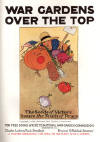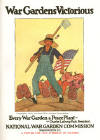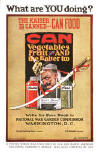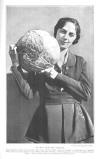The War Garden Victorious
CHAPTER II
THE STORY OF THE WAR GARDEN
How American Gardeners sowed the Seeds of
Victory
While the organizers of the War Garden Commission were optimistic and
looked forward confidently to the accomplishment of large results, they little dreamed that the
war-garden movement would grow so rapidly. The war-garden idea struck a patriotic chord. The
American people answered the call to help win the war by producing food in their back yards with the
same unanimity and enthusiasm they had shown in responding to each other appeal the country had made
for service. One reason for the prompt and eager response to the National War Garden Commission's
appeal to "Sow the Seeds of Victory": was that immediately after the United States entered the war
everybody was patriotically desirous of rendering help in some form. Millions of people realized
that they would never be able to take part as actual soldiers in the great task of overthrowing
Prussian militarism. Because of this they wanted to take an active part in some effort which would
show tangible results in the struggle for right and justice.
War gardening
offered the opportunity. Although small home plots might not produce large amounts of food, such
gardens made possible the saving of some of the wheat and meat and other foods which were needed by
our army and which were practically the only kinds of food that could be shipped to our allies.
Every pound of beef that could be saved through the growing of food at home, it was realized, would
bring victory just so much nearer; and in fact, without food conservation, there was positive danger
that the Central Powers would be able to have their way.
The Seeds of Victory Insure the Fruits of Peace
A POSTER SPREADING THE IDEA OF MILITANT WAR GARDENS

The food shortage faced by Great Britain, France, and
Italy during the winter of 1917-1918, the seriousness of which was not realized by the people of
this country until long after the danger was passed, showed the wisdom which led to the saving of
every particle of food. The ability of the United States to respond so magnificently to the appeal
of the late Lord Rhondda, then Food Controller of Great Britain, for 75,000,000 additional bushels
of wheat early in 1918, was made possible in part by substituting in the dietary, war-garden
products for the customary commercial supplies.
Once embarked upon
participation in the war it became evident that this nation would need to exert every ounce of her
power in the prosecution of the conflict. In various localities anti-loafing laws were speedily
enacted to put every man to work. Since food was even more necessary than man-power, it was of still
greater importance to put to use every particle of "slacker land"–idle soil so located
that it could be worked. In our cities and towns, where the manpower was available to cultivate
these areas, were thousands upon thousands of acres of idle real estate.
Few people realized the enormous aggregate acreage thus
standing useless. There was probably no town i the United States that did not have within its
boundaries at least fifty acres of idle soil. In the larger communities where garden space was
needed most, the aggregate area of vacant lots was astonishing. A survey made in Minneapolis,
shortly before the war began, showed more than 5,000 acres in vacant lots. In 1917 a survey
disclosed 186,000 vacant lots in greater New York. Altogether there were hundreds of thousands of
idle acres in or near our towns and cities–the only places where labor was available for
working them; and much of this land was suitable for gardening. It was of the utmost importance,
therefore, to place these areas under cultivation.
In Great Britain steps
had been taken very early in the war to utilize similar open spaces for the production of food.
Parliament passed a law providing that any untaxed land which was not being used for the production
of food might be taken over by the authorities and parceled out to those who were able and willing
to raise food. Millions of "Allotments," as they were called, were asked for, and the
production of vegetables increased incredibly. Thus the British were able in 1918 to produce all the
potatoes they needed, and even to send a slight surplus to France. American possessed vast areas, in
the aggregate, of these idle lands; but the importance of utilizing them for food production had not
been generally realized, until pointed out by the Commission.
Every War Garden A Peace Plant
A POSTER FOR 1919, SYMBOLIC OF VICTORY

"Put the slacker land to work" became a slogan of the
National War Commission; and in response to its energetic campaign toward this end, the people in
1917 put to work more than 3,000,000 pieces of such uncultivated territory. In 1918 they ferreted
out additional vast areas. The total number of war gardens for this latter season is conservatively
estimated, after a careful survey, at 5,285,000.
With war's destruction
occurring to an undreamed of and terrifying extent, involving the destruction of all kinds of
material wealth as well as food, it soon became apparent that food shortage was only one of many
shortages the world was facing. Conservation of everything became a crying need. The war garden
offered an opportunity for conservation along many lines. First came the conservation of food
itself. The daily ration of a soldier in our army consists of about four and a quarter pounds of
food. A million soldiers would require at least 4,250,000 pounds of food a day. At this rate a
year's supply of food for a million men would weigh 1,551,250,000 pounds–and we were planning
to raise an army of four or five million men. To take from the ordinary channels of trade the
colossal supplies necessary to feed such an army, with no extra food to replace that thus
subtracted, would mean that householders would be forced to pay ruinously high prices for the food
that remained. War gardening offered an opportunity to offset, in part, this tremendous drain on our
commercial supplies, to eke out those supplies and make them go farther–which is really
conversation in its truest sense.
War gardening promised to make many other things go
farther. There was the matter of labor. There was only so much labor in existence. As the primary
requisite of war, food would have the first call on labor, although other things besides food were
needed. Cannon and shells and rifles and cartridges and uniforms and innumerable other articles were
demanded in incomprehensible quantities. After taking four or five million men away from productive
industry, obviously we should not have sufficient man-power left to create all that was needed of
these various supplies. War gardening, by adding to the food supply, released for work on these
lines men who otherwise would have been necessary on the farms. In short, war gardening conserved
labor by making labor go farther.
The conservation, however, did not end
with lessening the number of men needed on the farms. Commercial foods must pass through many hands
before reaching the consumer. They must go through the hands of the farmer, the railroader, the
wholesaler, the retailer, the city deliveryman. For instance, a cabbage bought in the market is
handled by almost all the men enumerated. A cabbage grown in the back yard is "Food F.O.B. the
Kitchen Door." No one needs to handle it except the person who produces it for he or she is also the
one who eats it. Suppose that the average backyard garden produces only a hundred pounds of food,
which is a ridiculously small estimate, as a single bushel of potatoes weighs sixty pounds. Based on
this the 5,285,000 war gardens of 1918 yielded at least 528,285,000 pounds of food. Actually, as we
shall see later, the yield was many times as great. Yet the handling of that vast weight of
provender called for hardly a single public carrier of goods. The army of men which otherwise would
have been needed to transmit this food from producer to consumer was thus released for other
essential labor. It probably would not be possible to figure just how much was accomplished in this
manner by the war gardeners of the United States; but it is safe to say that the men thus release
for other work numbered many thousands.
Can Vegetables, Fruits and the Kaiser too
A POSTER WHICH WAS USED FIRST IN 1918 AND WHICH, AMENDED–FOLLOWING GERMANY'S DEFEAT–WAS ALSO FORCEFUL IN 1919

While this conservation of labor was being accomplished there was a concurrent saving in still another way, through the release of thousands of freight-cars, motor-trucks, and wagons, for purposes other than the hauling of food. This saving, too, was most vital. At a time when every freight-car in the country was urgently needed for the hauling of raw materials to be used in the manufacture of munitions of ar, for the transportation to the seacoast of finished products, and for hauling lumber and supplies to cantonments and army camps, it was essential that not one foot of freight space should be wasted. War gardening released thousands of cars for these essential needs. This saving, it must be remembered, involved also the conservation of coal and steam-power required in hauling, and prevented, as well, a great amount of wear and tear on railroad tracks and equipment.
To secure all these ends a campaign of education was
necessary. This campaign had to be extensive in range and intensive in method. As an educator of the
masses there is no power equal to the public press; and from the start, the Commission, had the
cordial cooperation of the newspapers and periodicals of the entire country. Inspiration and
detailed instruction were furnished through the columns of the daily newspapers. Articles and
feature stories which dealt with various phases of war gardening and sought to stimulate the
movement to the utmost were also prepared and sent broadcast.
These appeals
soon bore fruit. Requests for instruction in gardening and in the organization of community
gardening movements poured in from all sides. To the requests the Commission responded with
carefully prepared pamphlets which gave the information desired. In addition, representatives of the
Commission visited innumerable cities and towns to confer with the local chambers of commerce or
other organizations which were directing gardening campaigns. As a result of this propaganda, war
gardens sprang up as though by magic. Gardening came to be the thing.
In
order that all this enthusiasm might be transmuted into substantial accomplishment, it was necessary
that the army of would-be gardeners should have instruction, for many of them had never before
handled a hoe or wielded a fork. Daily garden lessons were prepared therefore for the daily press.
These lessons were short and simple, shorn of useless technicalities, but carefully prepared by
experts. They were lacking in nothing essential. They gave the fundamentals of good garden practice,
which would enable even a beginner to make a success of his endeavor. In addition a book was printed
explaining how to plant and care for the different vegetables. A copy of this book was free to any
one upon request and several million copies have been given away in response to request. Many copies
were also distributed through the agency of libraries, chambers of commerce, trade bodies, women's
clubs, banks, manufacturing concerns and the like. Thousands of letters of appreciation prove how
helpful were these books.

NO "SLACKER LAND" HERE
Not a square foot of vacant space has been
allowed to go to waste. Vegetables are growing right up to the edge of the walks and the walls of
the surrounding buildings. This home food producer in East Liberty, Ohio, could almost gather his
garden products without stepping off the porch.
To encourage the conservation of garden products
canning an drying manuals were prepared and distributed through the same channels which had handled
the garden books, and daily lessons on canning and drying were sent to the newspapers for
publication. The results were most gratifying. Editors everywhere devoted generous space to the
articles sent them, including news stories, technical matter on canning and drying, and ample
illustrations. Cartoonists, paragraphers, and writers of comics also made gardening their theme; and
some of the productions the Commission scattered broadcast, to keep alive the interest in home food
production and preservation.
The prose poem, so popular these days, was used
to catch the eye and arouse the interest of "city farmers." Here is one, entitled "Let's Dig and Dig
and We'll be Big:"
When I go down the village street in my perambulations, most every other chap I meet is asking for donations. They're seeking funds for Red Cross work, for hospitals and motors; they're holding up with constant jerk, all wives and kids and voters. I'm helping out from day to day, with no delays or pauses, tobacco funds, Y.M.C.A. and other worthy causes. I'm told that war bonds I must buy, in twos and fours and dozens, enough to make a full supply for all my aunts and cousins. For war stamps, too, those signs of thrift, I dig into my pocket, to give my Uncle Same a lift in cleaning up his docket. I'm taxed for building wooden ships with good, old-fashioned rigging, and in my little daily trips I'm constantly kept digging. I dig to pay tobacco tax, and tax for railway travel. I'm always chipping from my stacks; they keep me scratching gravel. But I've no kick for those who come with all their pleas beguiling. It never makes me sad nor glum. They always find me smiling. I know that I'm too old to fight; I can't be caught renigging. So I regard it just and right that I should keep on digging. And then besides, it's proved to me that every man is bigger if he will teach himself to be a willing war-time digger. It's not enough for us to sing about the joy of giving. We've got to dig for everything we need to keep on living. We've got to dig in our back yards for carrots, beans, and 'taters' we've got to dig both long and hard as garden cultivators. So take your trusty hoe and spade and start your spring-time sowing. Just dig and get a garden made and set the foodstuff growing.

ONE OF CLEVELAND'S WAR GARDENS
Working under pressure to produce munitions for the armies did not
keep the great industrial centers from developing their war gardens. Cleveland was notable for its
success in "growing munitions of war at home." The Xavia garden on East Sixty-third street is here
pictured as a typical home muntion plant.
In order to catch the attention
of the man in the street, several striking posters were prepared by the Commission and placed in
conspicuous places in communities in every part of the land. On bulletin-boards, in railway
stations, libraries, stores, at factory entrances, and even in clubs, banks and commercial houses,
these striking posters met the eye. They were also reproduced in newspapers and magazines and thus
scattered throughout the length and breadth of the land. Many were even sent to foreign lands in
answer to requests for help in stimulating gardening.
These posters were the
work of artists of national reputation. One of the posters, most beautiful in its richness of
coloring and most striking in its patriotic appeal, was drawn by James Montgomery Flagg. It was
entitled: "Sow the Seed of Victory." At the bottom it bore another of the slogans of the Commission:
"Every Garden a Munition Plant." This poster without doubt was a powerful influence in persuading
many an American citizen to get into his back yard and help grow some of the "ammunition" needed in
fighting the enemy. Another poster, by Frank V. DuMond, showed the Goddess of Victory. Maginel
Wright Enright created two striking posters for the commission. They were entitled: "War Gardens
Over the Top," and "War Gardens Victorious."
One of the posters used by the
Commission in arousing the war gardeners of the country to the importance of conserving vegetables
for future use, was popularly known as the "Can the Kaiser" poster. Most appropriately this famous
poster was the work of a Belgian, J.Paul Verrees, a soldier-artist, who was wounded in one of the
early battles of the war while helping to defend his country, and who, incapacitated for further
military service, later came to the United States to follow his profession.
One of the most inspiring and satisfactory features of
the rapid growth of the war-garden movement was the spread of the idea to foreign countries. Advice
was gladly given to foreign inquirers, the Commission furnishing detailed information concerning the
methods which had resulted in such general enthusiasm for war gardening in the United States. In
response to numerous requests which came to the Commission from all parts of the world, large
quantities of printed matter, including garden and canning books, posters, and pamphlets, were sent
broadcast throughout the world.
"Kia Ora," the Maroi way of saying,
"Salutations to you all," was the greeting which came to the Commission from far-off New Zealand, in
a letter of thanks from F. Carr Follett, of the Auckland Herald, for data and material
that had been sent. From Buenos Aires, Argentina, on the opposite side of the globe, C.D.
Middlebrook, of the Sociedad Anonima La Blanca, wrote a hearty letter of appreciation for posters
and other literature sent, saying that the posters were prominently displayed on the occasion of the
entertainment of two hundred American bluejackets who visited this South American capital. "Down
here we appreciate this class of propaganda," said Mr. Middlebrook, "and we are in a position to
exhibit the posters where they can readily be seen by the public. Practically every American home
and sympathizer displays them. We will do our part in making this propaganda public."

NO WONDER SHE SMILES:
Thousands of men and women who had never before
the war raised a cabbage or a potato were just as much pleased as is Miss Dorothy Primm, of
Minneapolis, over the results of their labor. They found that even amateurs could succeed.
From South and Central American countries, from Cuba,
India, China, Japan, the Philippines, Alaska, Hawaii, South Africa, and from a number of European
nations cam requests for information and instruction on war gardening. Even Lord Rhondda, as British
Food Controller, cabled a request for 5,000 copies of the Commission's book on
gardening.
No new movement could have spread with such rapidity and been
rewarded with such results as were achieved, had it not been for the loyal and whole-hearted manner
in which state, county and town committees and officials of all sorts, as well as numerous
individuals, cooperated with and supplemented the work of the Commission. With this help the results
surpassed the most sanguine anticipations of those who initiated the war-garden movement. The first
season saw the planting in the United States, according to the Commission's estimates based on
reports from all parts of the country, of approximately 3,500,000 home food producing lots. The
reports gathered in 1918 showed the number had increased to 5,285,000.
Furthermore, there was more intensive cultivation and a greater proportion of large-yielding gardens
in 1918 than during the preceding year. The food value of the 1917 products was estimated at
something like $350,000,000. In the second year the value reached an estimated total of
$525,000,000.
It is estimated, likewise, that as a result of the garden and
canning campaigns, there were put up and stored away on pantry shelves in 1917 more than 500,000,000
quarts of canned vegetables and fruits; while in 1918 the number of such jars is believed to have
been fully 1,450,000,000.
Assuredly tall oaks from little acorns grow.